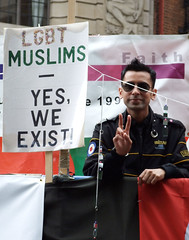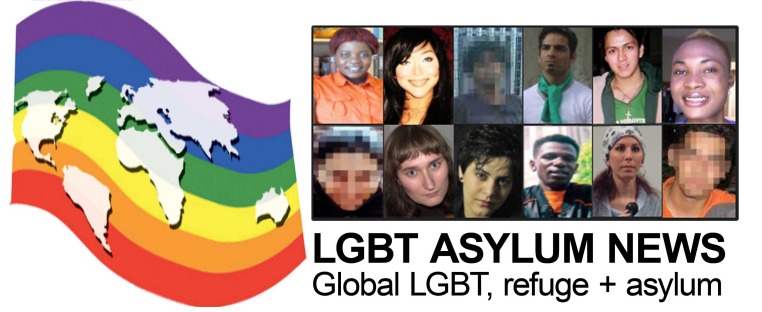 Image by lewishamdreamer via Flickr
Image by lewishamdreamer via FlickrBy Peter Montgomery
Just as the Arab spring has upended conventional understanding of Arab and Muslim societies, so a new report on the issues faced by LGBT Muslims challenges the stereotype of Muslim communities in the U.S. and abroad as monolithically closed to conversations about sexuality.
The report, the “Muslim LGBT Inclusion Project,” was just published by Intersections International — New York-based nonprofit whose mandate, says founding director Rev. Robert Chase, is to bring together people who differ, honor those differences, and find ways to work together for reconciliation, justice, and peace.
The report builds on interviews with Muslim community leaders, several scholarly articles, as well as facilitated discussions among more than 50 people in six cities. Chase, who co-facilitated five of the six group discussions, says those conversations revealed a remarkable openness. “It was just fascinating,” he says:
I went in looking to do an assessment, and came out being inspired with real hope for our whole world. One part of our world that is so often demonized as being insensitive and rigid and uncompromising and out of touch with nuances of human history proved to be just the opposite: engaged, sensitive, curious, imaginative.He concluded, “if this is the demonized community, then our future is a lot brighter than what we’ve been led to believe.” Chase acknowledges that the group participants skewed progressive, but the prevalence of progressive-oriented Muslim community leaders may itself be news to many Americans.
Cultural Imperialism, or Human Right?
Most project participants agreed that conversations about LGBT issues within the Muslim community might better be pursued outside of mosques rather than within them. Those who did support direct religious engagement argued for starting with the notion of Allah as a God of mercy and compassion.
LGBT Muslims, the report notes, are dealing with many of the same kinds of questions that LGBT Christians have been dealing with for decades—such as the authority and interpretation of scripture. In addition, conversations within Islam in America are complicated by a virulent Islamophobia that has flourished in the decade since the 9/11 attacks. As scholar Hussein Rashid, an RD associate editor, observes: “The intersection of sexual, religious, racial, and immigrant identities entail multiple types of marginalization.”
Accompanying the rise of Islamophobia has been an effort by some Islamic leaders to defend the faith by resisting what they see as forces of Western cultural hegemony, which include topics such as gender and sexual orientation. The report quotes scholar Kecia Ali saying,
Those who have appointed themselves the guardians of communal orthodoxy are particularly vigilant on matters concerning women and gender—in part because it is in these realms that the construction of Muslim identity in self-conscious opposition to a decadent West takes place.Munir Shaikh, executive director of the Institute on Religion and Civic Values, writes that “The LGBT cause is perceived by many to be simply another form of cultural imperialism, not a matter of human rights.”
It was not uncommon, in fact, for participants to suggest that LGBT issues should be put on hold until the community has better addressed Islamophobia. But others suggest that bullying of Muslim and gay kids can provide common ground (what one DC parent called a “cognitive opening”) to forge solidarity among two often marginalized groups.
Many participants viewed mosques themselves as less open to conversation on LGBT issues, but the report suggests that mosques do not play as dominant a role in defining community attitudes as some may presume.
A Pew survey in 2007 reported that one-third of American Muslims said they seldom or never attended a mosque. Participants in the Intersections discussions said they believed that 70 to 80 percent of Muslims in America do not belong to their local mosque.
Looking forward, the report suggests that students and student groups would be a more effective place to begin raising the visibility of LGBT Muslims and their concerns in the broader community. Young Muslims, particularly second- and third-generation Muslims in America, are, like their youthful counterparts in other religious traditions, are more open to notions of LGBT equality. And they are immersed in the social networking technologies that have been so evident in the Arab spring uprisings.
Not Just One Version of Islam
The report’s scholars addressed, in three separate articles, the important idea that there is not one single Islamic approach to issues of same-sex attraction. In fact, bringing forth the varied historical approaches to homosexuality in Muslim cultures, the report suggests, is an essential step in challenging the notion that Islam is inevitably and implacably unwelcoming to LGBT people. It is important, writes Rashid, to show that there are a wide variety of interpretations of Islam.
Another major theme: the historical and ongoing gulf between Muslim-majority countries and the West on the notion of homosexuality as an identity rather than a practice. Different cultural understandings can complicate conversations about sexuality, and make it hard to simply transfer the rhetoric and strategies of Western LGBT-rights movements to Muslim countries. Considering the identity-practice divide also allows for understanding as something more than simple buffoonery the statement by Iranian President Ahmadinejad that Iran has no homosexuals—the category itself is seen as a Western invention.
In her article, Aisha Geissinger explores a more fluid understanding of gender and an openness toward same-sex desires that is revealed in much poetry and literature from pre-19th-century Islam. She says, for example, that “poetry with homoerotic themes was composed in all of the major literary languages used by medieval Muslims.” The Qur’an, Rashid adds, acknowledges that some men are not attracted to women; and Geissinger writes that there is evidence that even among those surrounding the Prophet Mohammed, men with female characteristics were permitted to fraternize with women.
While Islam always included proscriptions against anal sex, the report says, there was widespread acceptance of the existence of same-sex attraction and longing, particularly in the context of men attracted to adolescents.
The hardened strictures against homosexuality, the authors suggest, as well as the shame and stigma associated with same-sex attraction, are in part thanks to the influence of British colonizers. In other words, suggests the report, the taboos around same-sex relationships are “a contrived Western phenomenon imposed on the Muslim world.”
Munir Shaikh, whose paper focuses on contemporary developments, acknowledges the seriousness of the challenges that LGBT Muslims face. Even mainstream Islamic leaders known for efforts at mutual respect and reconciliation with other religions, he says, tend to take a consistent anti-homosexuality stand, suggesting that it is not possible to be gay and Muslim (something that will sound familiar to many gay Christians). That, combined with a focus on marriage and family as central to community social order, has meant that many LGBT Muslims remain on the “down low”—many in marriages of convenience.
In Muslim countries that harshly punish homosexuality, the report notes, those punishments are often drawn from religious teachings about punishing adultery, but without the high evidentiary bar called for in the Qur’an—such as multiple eyewitnesses—that apply in other cases. This disparity, says Rashid, “speaks to a level of patriarchal homophobia that results in unequal application of the law.”
Making Change Visible
But change is in the air, both Muslim majority countries and in the West. In America, the Human Rights Campaign recently hosted a reception for Muslims for Progressive Values, which describes itself as “an inclusive community rooted in the traditional Qur’anic ideals of human dignity and social justice. Shaikh notes that both two Muslim members of Congress, Reps. Keith Ellison and André Carson, are members of the LGBT Equality Congress, and that mainstream Muslim organizations supported the 2009 hate crimes bill that expanded federal law to include crimes based on a person’s sexual orientation or gender identity.
Overseas, for example, the Lebanese organization Helem, founded in 2004, published Homophobia: Views and Positions, which includes “contributions from some of Lebanon’s most gifted writers, intellectuals, and activists, sparking much-needed conversation about the violence that LGBT individuals face.” Shaikh calls the book “the first of its kind in Arabic in the region.” Helem is also launching an online homophobia monitor.
Participants in the Intersections International project were aware of the global implications of their conversation, with many expressing gratitude that the United States provides a safe place to have conversations that would be hard to hold in most Muslim countries. Greater visibility in the U.S. can encourage individuals and fledgling organizations through social networking and global media.
Generating that visibility is part of the task ahead. The Muslim LGBT Inclusion report identifies two next steps: generating greater financial support to strengthen LGBT Muslim groups and building greater awareness and sensitivity within the wider Muslim community for the concerns of LGBT Muslims. One specific project under consideration is the production of toolkits for creating welcoming mosques.
Another open question, says Chase, is how to share with the American public the kind of thoughtful and caring conversation that took place among people with many disagreements on a potentially contentious topic. Chase notes that 60 percent of Americans say they don’t know a single Muslim. Says the report:
A regret shared by facilitators of these conversations on more than one occasion was that this experience could not have been witnessed by the American public. The rich diversity within the Muslim community, the respectful disagreements that took place during the course of the conversations, the thoughtful manner and sensitive insights with which the topic was addressed, the appreciation for living in a country where such a conversation could take place, and the continual returning to the root of a merciful and compassionate God in building a theological/religious foundation for inclusion of all is not a perception of American Muslims widely shared by non-Muslims in this country.
Muslim LGBT Report








 Join our page
Join our page


0 comments:
Post a Comment